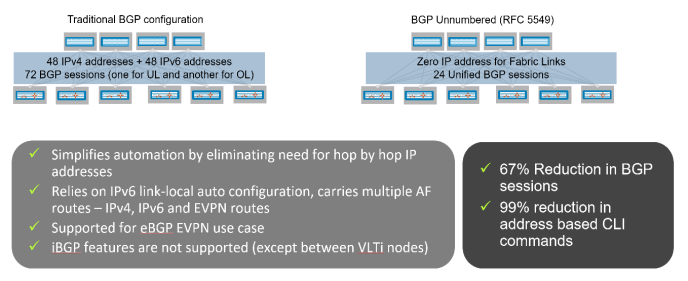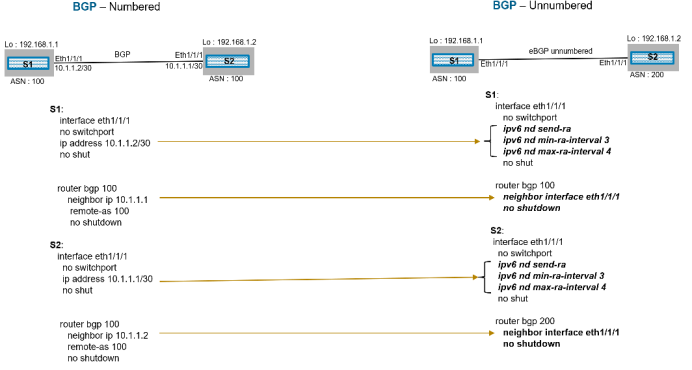Home > Networking Solutions > Enterprise/Data Center Networking Solutions > SmartFabric OS10 Networking Solutions > Guides > OS10 10.5.1 Feature - Unnumbered BGP - Technical Note > Unnumbered BGP
Unnumbered BGP
-
The Unnumbered BGP feature works by discovering the peer routers that are attached to point-to-point links by parsing the Router-advertisements (RA). Each router originates an RA periodically with its link-local address and its MAC address. BGP protocol configured with an unnumbered interface receives this information and parses the contents to set up peering with the other end device.
For Unnumbered BGP, the feature the session is established over an IPv6 link-local address, but the route prefixes exchanged can be of both IPv4 and IPv6 address-family type. This is achieved by using the extended next-hop encoding mechanism as specified in RFC 5549.
Unnumbered BGP is supported for external BGP EVPN use case only in the current SmartFabric OS10 10.5.1 version. This means that all the nodes in the CLOS topology use unique ASN numbers for BGP peering. Note that iBGP features are not supported except between VLTi nodes in the leaf layer.
The benefits of using Unnumbered BGP over the traditional Numbered BGP are shown in the following figure:

Figure 1. Benefits
The figure below shows a comparison of numbered BGP and Unnumbered BGP CLI commands on a point-to-point link between two BGP nodes. Note that the unnumbered use case uses eBGP with two distinct ASN numbers on each node. As mentioned before, the current implementation in SmartFabric OS10 does not support iBGP sessions except between VLT node pair.

Figure 2. Numbered and Unnumbered BGP configuration comparison
Configuring BGP peering between many network devices in a data center can become quickly repetitive, boring, and hence open to human errors. One of the prerequisites for BGP to establish peering is to have IP addresses configured for L3 communication. This requires IPv4/IPv6 address configuration on links connecting neighboring routers. The BGP neighbors will only connect and exchange routes when all of the configurations are correct. To avoid all these issues, use Unnumbered BGP.
Configure a BGP neighbor by providing the interface name on which the peer is connected instead of the neighbor’s IP address. The interface should be routing-capable (no switchport), and it is recommended not to be configured with any IPv4/IPv6 address configuration. For the benefit of neighbor discovery, the user must enable Router Advertisement (RA) using the CLI ipv6 nd send-ra command for that interface.
